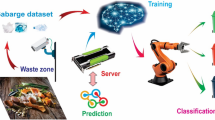Abstract
Separation of waste is an essential step in the recycling process, which can save resources, provide energy and reduce environmental pollution. Separation is a tedious process which is usually done by human workers, who hand-pick the items to separate them. To make this process easier, more accurate and safer, in this work a system is developed that can classify items using image recognition techniques and output classes using a projector. A dataset of 12 (of which eight are combined into a single “others” class, due to them being uncommon) different classes with about 5000 images in total is collected and used to train different classification models using convolutional neural networks and transfer learning. A mean accuracy of 74.043%±12.621% is achieved on test data in 10-fold cross-validation. Unfortunately, the model performs drastically worse on newer data, due to unknown reasons.
Access this chapter
Tax calculation will be finalised at checkout
Purchases are for personal use only
Similar content being viewed by others
References
Asmatulu, R., Asmatulu, E.: Importance of recycling education: a curriculum development at wsu. J. Mater. Cycles Waste Manag. 13(2), 131–138 (2011)
Jacobson, M.Z.: On the causal link between carbon dioxide and air pollution mortality. Geophys. Res. Lett. 35(3) (2008)
Adedeji, O., Wang, Z.: Intelligent waste classification system using deep learning convolutional neural network. Procedia Manuf. 35, 607–612 (2019)
Bobulski, J., Kubanek, M.: Waste classification system using image processing and convolutional neural networks. In: International Work Conference on Artificial Neural Networks, pp. 350–361. Springer (2019)
Bobulski, J., Piatkowski, J.: Pet waste classification method and plastic waste database-wadaba. In: International Conference on Image Processing and Communications, pp. 57–64. Springer (2017)
Gupta, N.S., Deepthi, V., Kunnath, M., Rejeth, P.S., Badsha, T.S., Nikhil, B.C.: Automatic waste segregation. In: 2018 Second International Conference on Intelligent Computing and Control Systems (ICICCS), pp. 1688–1692. IEEE (2018)
White, G., Cabrera, C., Palade, A., Li, F., Clarke, S.: Wastenet: Waste classification at the edge for smart bins (2020). arXiv:2006.05873
Altikat, A., Gulbe, A., Altikat, S.: Intelligent solid waste classification using deep convolutional neural networks. Int. J. Environ. Sci. Technol. 19(3), 1285–1292 (2022)
Ruiz, V., Sanchez, A., Velez, J.F., Raducanu, B.: Automatic image-based waste classification. In: International Work-Conference on the Interplay Between Natural and Artificial Computation, pp. 422–431. Springer (2019)
Yang, M., Thung, G.: Classification of trash for recyclability status. CS229 project report, vol. 2016, no. 1, p. 3 (2016)
Zhang, S., Chen, Y., Yang, Z., Gong, H.: Computer vision based two-stage waste recognition-retrieval algorithm for waste classification. Resour. Conserv. Recycl. 169, 105543 (2021). https://www.sciencedirect.com/science/article/pii/S0921344921001506
Mao, W.-L., Chen, W.-C., Wang, C.-T., Lin, Y.-H.: Recycling waste classification using optimized convolutional neural network. Resour. Conserv. Recycl. 164, 105132 (2021)
Huang, G., Liu, Z., Van Der Maaten, L., Weinberger, K.Q.: Densely connected convolutional networks. In: Proceedings of the IEEE conference on computer vision and pattern recognition, pp. 4700–4708 (2017)
Krizhevsky, A., Sutskever, I., Hinton, G.E.: Imagenet classification with deep convolutional neural networks. In: Pereira, F., Burges, C., Bottou, L., Weinberger, K. (eds.) Advances in Neural Information Processing Systems, vol. 25. Curran Associates, Inc. (2012). https://proceedings.neurips.cc/paper/2012/file/c399862d3b9d6b76c8436e924a68c45b-Paper.pdf
He, K., Zhang, X., Ren, S., Sun, J.: Deep residual learning for image recognition (2015). http://arxiv.org/abs/1512.03385
Simonyan, K., Zisserman, A.: Very deep convolutional networks for large-scale image recognition (2014). arXiv:1409.1556
You, K., Long, M., Wang, J., Jordan, M.I.: How does learning rate decay help modern neural networks? (2019). arXiv:1908.01878
Prechelt, L.: Early stopping-but when? In: Neural Networks: Tricks of the Trade, pp. 55–69. Springer (1998)
Deng, A., Li, X., Li, Z., Hu, D., Xu, C., Dou, D.: Inadequately pre-trained models are better feature extractors (2022). arXiv:2203.04668
Seeland, M., Mader, P.: Multi-view classification with convolutional neural networks. PLoS ONE 16(1), e0245230 (2021)
Author information
Authors and Affiliations
Corresponding author
Editor information
Editors and Affiliations
A Appendix
A Appendix
1.1 A.1 Data and Source Code
The data and source code is available in the corresponding GitHub repository:
https://github.com/marc131183/WasteClassification
1.2 A.2 All Cross-Validated Models
All model variants that were cross-validated can be seen in Table 4. The ones which are also presented in Table 3 are written boldly.
Rights and permissions
Copyright information
© 2024 The Author(s), under exclusive license to Springer Nature Switzerland AG
About this paper
Cite this paper
Gröling, M., Huang, L., Hameed, I.A. (2024). An Unmanned System for Automatic Classification of Hazardous Wastes in Norway. In: Arai, K. (eds) Intelligent Systems and Applications. IntelliSys 2023. Lecture Notes in Networks and Systems, vol 824. Springer, Cham. https://doi.org/10.1007/978-3-031-47715-7_10
Download citation
DOI: https://doi.org/10.1007/978-3-031-47715-7_10
Published:
Publisher Name: Springer, Cham
Print ISBN: 978-3-031-47714-0
Online ISBN: 978-3-031-47715-7
eBook Packages: Intelligent Technologies and RoboticsIntelligent Technologies and Robotics (R0)




